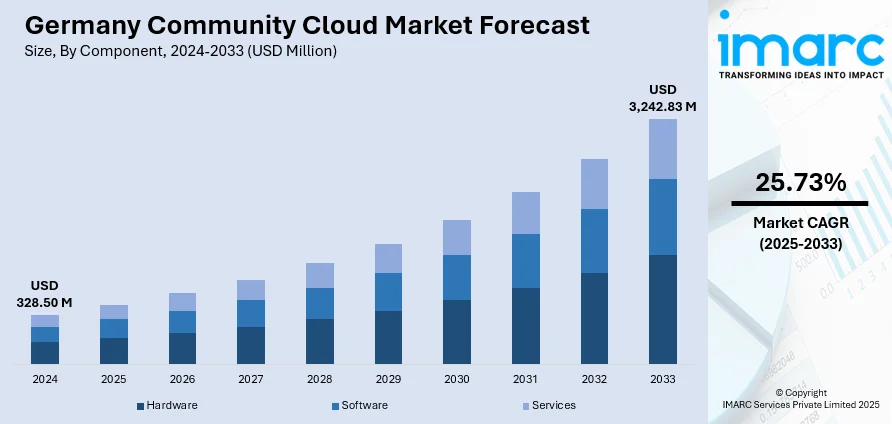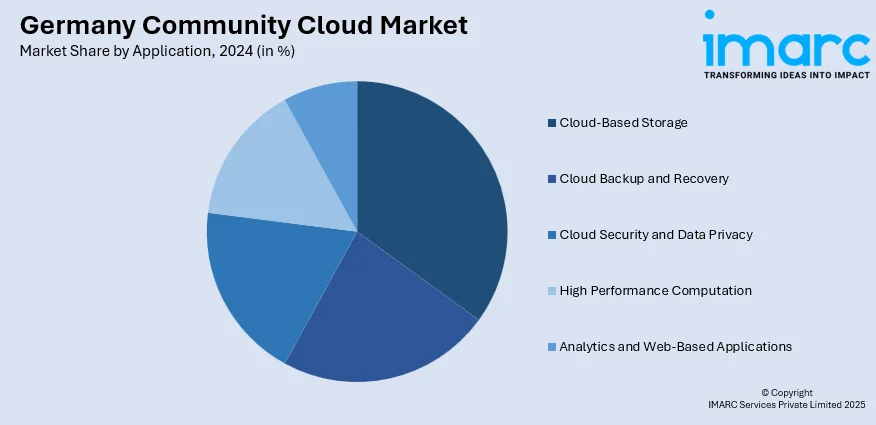
Germany Community Cloud Market Size, Share, Trends and Forecast by Component, Application, Industry Vertical, and Region, 2025-2033
Germany Community Cloud Market Overview:
The Germany community cloud market size reached USD 328.50 Million in 2024. The market is projected to reach USD 3,242.83 Million by 2033, exhibiting a growth rate (CAGR) of 25.73% during 2025-2033. The market is driven by rising adoption by public sector organizations, academic institutions, and regulated industries. The need for safe, compliant, and collaborative digital spaces is fueling investment in regionally governed cloud infrastructures. With emphasis on data sovereignty, sector-focused customization, and collaborative IT governance, community cloud approaches are gaining traction. They all together boost operational effectiveness and regulatory compliance for businesses, bringing a significant increase in Germany community cloud market share.
|
Report Attribute
|
Key Statistics
|
|---|---|
|
Base Year
|
2024 |
|
Forecast Years
|
2025-2033
|
|
Historical Years
|
2019-2024
|
| Market Size in 2024 | USD 328.50 Million |
| Market Forecast in 2033 | USD 3,242.83 Million |
| Market Growth Rate 2025-2033 | 25.73% |
Germany Community Cloud Market Trends:
Increasing Public Sector Digitalization Driving Community Cloud Demand
The public sector in Germany is accelerating digital transformation, propelling an increasing demand for cloud solutions that focus on compliance, transparency, and collaboration. As per the reports, in January 2025, Heinlein Group introduced OpenCloud GmbH to provide GDPR-friendly, open-source file sharing solutions for public administrations, strengthening sovereign digital infrastructure and aligning with Germany community cloud market trends. Moreover, community cloud infrastructures are becoming an attractive model for public agencies, ministries, and municipal institutions for secure management of data with shared control. These cloud infrastructures ensure customized access to computing capacity and facilitate cross-agency integration, fostering efficient service delivery and economies of scale. In this governance-focused architecture, public authorities can have jurisdictional data residency and comply with national and EU privacy regulations without having to return to generalized commercial platforms. Germany's decentralized federal administration renders community clouds particularly pertinent, facilitating regional adaptation and shared responsibility. By leveraging alignment of IT plans across entities sharing like missions, such infrastructures enable continuity and trustworthiness of public digital services. Such greater institutional dependence is contributing heavily to Germany community cloud market growth, especially in regional and federated public service systems.

To get more information on this market, Request Sample
Sector-Specific Cloud Solutions Improving Business Efficiency
Organizations in Germany's highly regulated industries—healthcare, education, and finance—are increasingly moving to community cloud platforms to enhance security, performance, and operational predictability. These surroundings accommodate collaborative governance and adaptable frameworks, allowing institutions to define cloud services to meet their specific regulatory and procedural requirements. For instance, medical centers can safely handle patient data within GDPR regulations, while universities enjoy centralized access to study resources and learning platforms. Organizations conserve resources and eliminate redundancy by sharing resources within a community cloud, standardize data better, and gain economies of scale. This collaborative method enhances resilience while reducing IT expenses, particularly for organizations with comparable operational objectives. It also boosts innovation through cooperative development and deployment of sector-specific digital infrastructure. As institutions increasingly seek integrated and compliant IT solutions, the demand for secure and adaptable environments continues to rise. This shift is playing a pivotal role in shaping Germany community cloud market trends, particularly within public sector-driven domains.
Collaborative Cloud Governance Facilitating Regional Innovation
Germany's federal administrative organization and high level of regional autonomy are central drivers motivating the growth of community cloud infrastructures in regions such as Baden-Württemberg and North Rhine-Westphalia. The two are rolling out collaborative digital infrastructure initiatives promoting the use of locally controlled cloud environments with safe, standardized services across institutions and municipalities. Community clouds here facilitate coordinated policy implementation, centralized access to data, and standardized service delivery while ensuring total compliance with local and national regulations. Such coordination enhances agility in public sector IT operations and facilitates more coordinated planning of digital transformation projects. The models also allow municipalities, universities, and healthcare providers to collectively invest in scalable infrastructure, catalyzing long-term digital sustainability. Through enabling regional government and enabling multiple stakeholders to co-develop and co-govern cloud environments, community clouds are increasingly essential to public digital innovation. These trends are heavily driving German community cloud market expansion, promoting sovereign, federated management of cloud-based digital infrastructure.
Germany Community Cloud Market Segmentation:
IMARC Group provides an analysis of the key trends in each segment of the market, along with forecasts at the country and regional levels for 2025-2033. Our report has categorized the market based on component, application, and industry vertical.
Component Insights:
- Hardware
- Server
- Networking
- Storage
- Others
- Software
- Enterprise Application Software
- Collaboration Tools Software
- Dashboards Business Intelligence Software
- Services
- Training Services
- Maintenance and Support
- Regulation and Compliance
- Consulting
The report has provided a detailed breakup and analysis of the market based on the component. This includes hardware (server, networking, storage, others), software (enterprise application software, collaboration tools software, dashboards business intelligence software), and services (training services, maintenance and support, regulation and compliance, consulting).
Application Insights:

- Cloud-Based Storage
- Cloud Backup and Recovery
- Cloud Security and Data Privacy
- High Performance Computation
- Analytics and Web-Based Applications
A detailed breakup and analysis of the market based on the application have also been provided in the report. This includes cloud-based storage, cloud backup and recovery, cloud security and data privacy, high performance computation, and analytics and web-based applications.
Industry Vertical Insights:
- BFSI
- Gaming
- Government
- Healthcare
- Education
- Others
The report has provided a detailed breakup and analysis of the market based on the industrial vertical. This includes BFSI, gaming, government, healthcare, education, and others.
Regional Insights:
- Western Germany
- Southern Germany
- Eastern Germany
- Northern Germany
The report has also provided a comprehensive analysis of all the major regional markets, which include Western Germany, Southern Germany, Eastern Germany, and Northern Germany.
Competitive Landscape:
The market research report has also provided a comprehensive analysis of the competitive landscape. Competitive analysis such as market structure, key player positioning, top winning strategies, competitive dashboard, and company evaluation quadrant has been covered in the report. Also, detailed profiles of all major companies have been provided.
Germany Community Cloud Market News:
- In June 2025, AWS created a new German corporate entity to manage its future AWS European Sovereign Cloud. Launching by late 2025, the effort ensures EU-based operational control in full, facilitating GDPR and the Federal Data Protection Act of Germany compliance, as well as advancing sovereign cloud infrastructure across the region.
- In June of 2025, Nvidia and Deutsche Telekom unveiled plans to create Europe's first industrial AI cloud in Germany for manufacturers. Although privately owned, the initiative supports data sovereignty and joint sector infrastructure, a move consistent with Germany community cloud market trends that target secure, compliant, and collaborative digital solutions.
- In March of 2025, ZTE and Virtuozzo unveiled a Hyper-Converged Infrastructure solution at Germany's CloudFest. Aimed at non-traditional cloud providers, the platform caters to sovereign, software-defined environments in line with Germany community cloud market trends centered on secure, efficient, and autonomous cloud infrastructure for business and public sector customers.
Germany Community Cloud Market Report Coverage:
| Report Features | Details |
|---|---|
| Base Year of the Analysis | 2024 |
| Historical Period | 2019-2024 |
| Forecast Period | 2025-2033 |
| Units | Million USD |
| Scope of the Report |
Exploration of Historical Trends and Market Outlook, Industry Catalysts and Challenges, Segment-Wise Historical and Future Market Assessment:
|
| Components Covered |
|
| Applications Covered | Cloud-Based Storage, Cloud Backup and Recovery, Cloud Security and Data Privacy, High Performance Computation, Analytics and Web-Based Applications |
| Industry Verticals Covered | BFSI, Gaming, Government, Healthcare, Education, Others |
| Regions Covered | Western Germany, Southern Germany, Eastern Germany, Northern Germany |
| Customization Scope | 10% Free Customization |
| Post-Sale Analyst Support | 10-12 Weeks |
| Delivery Format | PDF and Excel through Email (We can also provide the editable version of the report in PPT/Word format on special request) |
Key Questions Answered in This Report:
- How has the Germany community cloud market performed so far and how will it perform in the coming years?
- What is the breakup of the Germany community cloud market on the basis of component?
- What is the breakup of the Germany community cloud market on the basis of application?
- What is the breakup of the Germany community cloud market on the basis of industrial vertical?
- What is the breakup of the Germany community cloud market on the basis of region?
- What are the various stages in the value chain of the Germany community cloud market?
- What are the key driving factors and challenges in the Germany community cloud?
- What is the structure of the Germany community cloud market and who are the key players?
- What is the degree of competition in the Germany community cloud market?
Key Benefits for Stakeholders:
- IMARC’s industry report offers a comprehensive quantitative analysis of various market segments, historical and current market trends, market forecasts, and dynamics of the Germany community cloud market from 2019-2033.
- The research report provides the latest information on the market drivers, challenges, and opportunities in the Germany community cloud market.
- Porter's five forces analysis assist stakeholders in assessing the impact of new entrants, competitive rivalry, supplier power, buyer power, and the threat of substitution. It helps stakeholders to analyze the level of competition within the Germany community cloud industry and its attractiveness.
- Competitive landscape allows stakeholders to understand their competitive environment and provides an insight into the current positions of key players in the market.
Need more help?
- Speak to our experienced analysts for insights on the current market scenarios.
- Include additional segments and countries to customize the report as per your requirement.
- Gain an unparalleled competitive advantage in your domain by understanding how to utilize the report and positively impacting your operations and revenue.
- For further assistance, please connect with our analysts.
 Request Customization
Request Customization
 Speak to an Analyst
Speak to an Analyst
 Request Brochure
Request Brochure
 Inquire Before Buying
Inquire Before Buying




.webp)




.webp)












